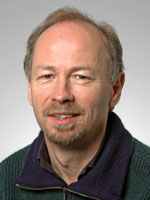Meet an employee at IFA
Monthly contribution from Søren Pape Møller, Center Director

Briefly explain your path to IFA/AU. Where have you been before?
"I studied mathematics and physics at AU from 1975 and graduated in 1981, where I was, among other things, a summer student at CERN and wrote my Master's thesis at CERN supervised by Erik Uggerhøj (deceased professor at IFA), who also later became a partner, mentor etc. It was therefore natural that I applied, and I got a Fellowship at CERN for 2 1/2 years. A fantastic period both academically, socially and familiarly with a good salary, fantastic surroundings with Geneva, the Alps and the Jura mountains in the backyard, and great opportunities at CERN. Abroad, I was also able to establish a family and first child. At CERN, I was able to get in touch with the accelerator world, and took part in the commissioning of LEAR, a new small (80m) ring at CERN for low-energy antiprotons. At CERN, I also collected all the material for a PhD project, which was completed after returning to IFA. Experiments at CERN continued for the next ten years, including experiments with very high energy, but also low-energy antiprotons at LEAR at CERN together with several others from IFA. Part of this work was later concluded with a doctoral dissertation."
What was the basis for your choice of job?
"At CERN, the ideas of a small ring at IFA, a la LEAR at CERN, also began. This was matured over several years, among other things with Erik Uggerhøj as the driving force and myself as a designer and sparring partner, and later along with many from both the technical and scientific units at IFA and elsewhere. This led to the introduction of many new technical expertises at the department, which has continued until this day. ASTRID was inaugurated in 1991 first as a storage ring for all kinds of ions, both positive and negative, and both light and heavy ions. As we were first in this area, it gave us a lot of opportunities, especially at the beginning, with "easy" and very visible experiments from IFA employees. As something new, ASTRID was also designed to store electrons, to produce short-wave length light and soft X-rays. Gradually, ASTRID was only used as a synchrotron radiation when I got the good idea (?), and later prize, to suggest, design and build the first electrostatic storage ring for ions of all kinds, ELISA. An area that has continued with other ion rings both at IFA and around the world. Later, as you know, we also ended up building ASTRID2 at IFA with Beamlines, experiments and users from both abroad, but also many users from AU and, in particular, IFA. This has also helped attract foreign researchers, several of whom are also employed at IFA today.
Funding for these major projects has been a patchwork, but also a few major Danish infrastructure grants, and support from a couple of deans. In addition, EU projects have been a source of financing for almost 15 years. In addition, IFA's competencies have also resulted in financial support for the operation of facilities at ASTRID and ASTRID2. "
What is your most proud work achievement(s)?
"For a number of years, I was responsible for the design of synchrotrons from the Danish company DANFYSIK in Jyllinge. These synchrotrons for synchrotron-radiation sources around the world resulted in deliveries to facilities in Germany, Canada and Australia. DANFYSIK was responsible for the construction and installation, whereas I and some of the employees from IFA were responsible for design, supervision and commissioning. This resulted in many trips around the world. Industrial PhD students also attended. After these projects, DANFYSIK entered into a contract with SIEMENS to build accelerators for cancer treatment, specifically using ions and not only protons, or electrons, which are usually used in radiation therapy. These machines cost around DKK 1 billion, and I accepted a job at DANFYSIK as a designer of these machines, among other things along with contacts to GSI in Germany. This resulted in facilities in Kiel, Marburg and Shanghai. After having built three such facilities, Siemens stopped this business, and today, DANFYSIK has a service contract for two of these facilities. The third has been demolished! These were very exciting and challenging projects and organisations, an experience I would not have been without. My job at DANFYSIK stopped after seven years, mainly because I had committed myself to applying for the ASTRID2 project. However, I would also like to mention my participation in connection with the establishment of the Danish Centre for Proton therapy at Aarhus University Hospital. Another major accelerator project involving Danish co-financing, which I and IFA have been involved in, is the European Spallation Source in Lund in Sweden. A project in which we, financed by ESS in Lund, has designed, built and delivered accelerator systems for the ESS within budget, and which have already been waiting for ESS for some time until the final installation and commissioning.
For many years, I have headed the ISA laboratory with ASTRID, and ASTRID2, etc., and in recent years the department's electronics unit."
What do you do in your spare time?
"In addition, there were several other projects, some teaching and supervision, but I would rather end by mentioning one of my passions. I have now danced Argentinian tango for over 20 years, among others with my wife, but also with many others, as is common in this “world”. It's nice to be able to dance with your partner, but to dance with others adds another dimension. On my travels around the world, I have often brought my tango shoes, and I have had fantastic dance experiences with strangers in, for example, Japan, China, Australia, the USA, etc. A well-defined interplay between a leader and a follower without verbal communication. It can be very conducive sometimes to do something completely different than physics!”
